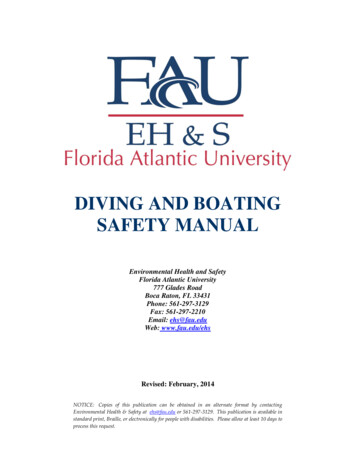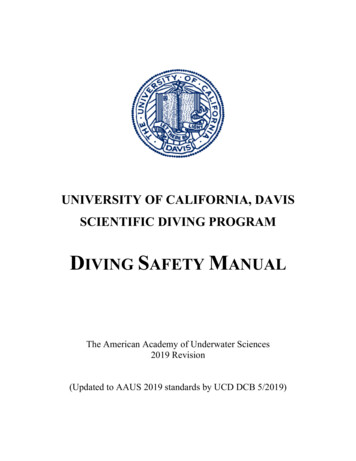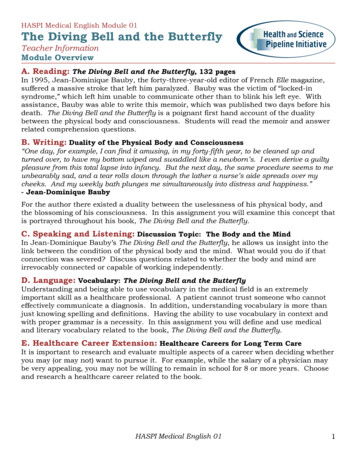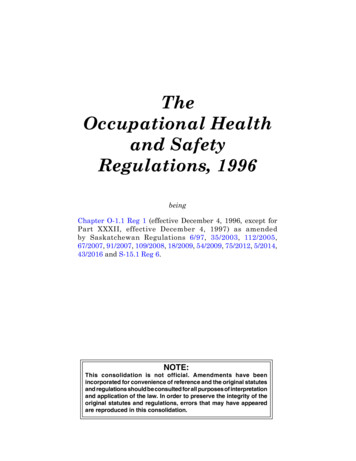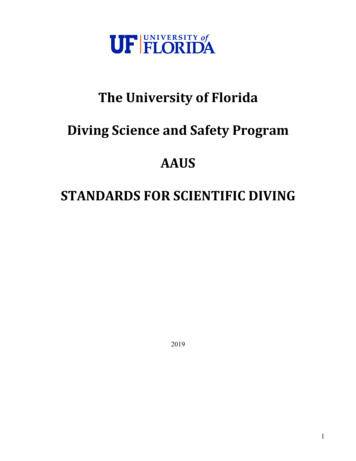
Transcription
The University of FloridaDiving Science and Safety ProgramAAUSSTANDARDS FOR SCIENTIFIC DIVING20191
FOREWORDSince 1951 the scientific diving community has endeavored to promote safe, effective divingthrough self-imposed diver training and education programs. Over the years, manuals for diving safetyhave been circulated between organizations, revised and modified for local implementation, and haveresulted in an enviable safety record.This document represents the minimal safety standards for scientific diving at the present day. Asdiving science progresses so must this standard, and it is the responsibility of every member of theAcademy to see that it always reflects state of the art, safe diving practice.American Academy of Underwater SciencesACKNOWLEDGEMENTSThe Academy thanks the numerous dedicated individual and organizational members for theircontributions and editorial comments in the production of these standards.Revision HistoryApproved by AAUS BOD December 2018Available at www.aaus.org/About/Diving Standards2
Table of ContentsVolume 1. 6Section 1.00 GENERAL POLICY .71.10 Scientific Diving Standards .71.20 Operational Control .81.30 Consequence of Violation of Regulations by Scientific Divers . 111.40 Consequences of Violation of Regulations by Organizational Members . 111.50 Record Maintenance . 11SECTION 2.00 DIVING REGULATIONS .132.10 Introduction . 132.20 Pre-Dive Procedures . 132.30 Diving Procedures . 142.40 Post-Dive Procedures . 142.50 Emergency Procedures . 142.60 Flying After Diving or Ascending to Altitude (Over 1000 feet/304 meters) . 152.70 Record Keeping Requirements . 15SECTION 3.00 DIVING EQUIPMENT .173.10 General Policy . 173.20 Equipment . 173.30 Auxiliary Equipment . 183.40 Support Equipment . 183.50 Equipment Maintenance . 18SECTION 4.00 SCIENTIFIC DIVER CERTIFICATION AND AUTHORIZATIONS .204.10 Prerequisites . 204.20 Training . 214.30 Diver Certification and Authorizations . 244.40 Depth Authorizations . 254.50 Maintaining Active Status . 264.60 Revocation of Authorization. 26SECTION 5.00 MEDICAL STANDARDS .275.10 Medical Requirements . 275.20 Frequency of Medical Evaluations. 275.30 Information Provided Examining Physician . 273
5.40 Content of Medical Evaluations . 275.50 Physician’s Written Report . 27Volume 2. 29SECTION 6.00 NITROX DIVING .306.10 Requirements for Nitrox Authorization. 306.20 Minimum Activity to Maintain Authorization . 316.30 Operational Requirements . 316.40 Nitrox Diving Equipment . 32SECTION 7.00 Surface Supplied Diving Technologies .337.10 Prerequisites . 337.20 Surface Supplied Diving . 337.30 Hookah. 33SECTION 8.00 STAGED DECOMPRESSION DIVING .34SECTION 9.00 MIXED GAS DIVING .35SECTION 10.00 SPECIALIZED DIVING ENVIRONMENTS .3610.10 Blue Water Diving . 3610.20 Ice and Polar Diving . 3610.30 Overhead Environments . 3610.40 Saturation Diving . 3610.50 Aquarium Diving . 36SECTION 11.00 REBREATHERS .3711.10 Definition . 3711.20 Prerequisites for use of any rebreather . 3811.30 Training . 3811.60 REBREATHER TRAINING SECTION . 41SECTION 12.00 SCIENTIFIC CAVE AND CAVERN DIVING .4712.10Definition . 4712.20 Prerequisites . 4812.30 Training . 4812.40 Equipment Requirements. 50Appendices . 52APPENDIX 1 DIVING MEDICAL EXAM OVERVIEW FOR THE EXAMINING PHYSICIAN .53APPENDIX 2 AAUS MEDICAL EVALUATION OF FITNESS FOR SCUBA DIVING REPORT .55APPENDIX 2b AAUS MEDICAL EVALUATION OF FITNESS FOR SCUBA DIVING REPORT .564
APPENDIX 3 DIVING MEDICAL HISTORY FORM .57APPENDIX 4 RECOMMENDED PHYSICIANS WITH EXPERTISE IN DIVING MEDICINE .58APPENDIX 5 DEFINITION OF TERMS .61APPENDIX 6 .66APPENDIX 7 EMERGENCY ACTION PLAN .67APPENDIX 8 AAUS STATISTICS COLLECTION CRITERIA AND DEFINITIONS .68Appendix 9 .71Recommendations For Rescue Of A Submerged Unresponsive Compressed-Gas Diver .715
Volume 1Sections 1.00 through 5.006
Section 1.00 GENERAL POLICY1.10 Scientific Diving StandardsThe University of Florida (UF) supports a large number of programs which involve scientificdiving operations. A partial list of the campus organizations that have engaged in some form ofscientific diving includes: the Botany Department, the Florida Museum of Natural History, theDepartment of Coastal and Civil Engineering, the Florida Sea Grant Extension Program, theDepartment of Zoology, the Department of Fisheries and Aquatic Sciences, the Whitney MarineResearch Laboratory and the University Marine Laboratory at Cedar Key. Accordingly, in 1987the University of Florida adopted standards set forth by the American Academy of UnderwaterSciences’ “Scientific Diving Standards for Scientific Diving Certification and Operation ofScientific Diving Programs”. The goal was to establish a scientific diving safety program that is1) legally defensible, 2) protects all scientific divers and 3) protects the State of Florida, UF, itsfaculty, staff and students.PurposeThe purpose of these Scientific Diving Standards is to ensure scientific diving is conducted in amanner that will maximize the protection of scientific divers from accidental injury and/orillness, and to set forth standards for training and certification that will allow a workingreciprocity between Organizational Members (OMs or OM). Fulfillment of these purposes shallbe consistent with the furtherance of research and safety, and facilitation of collaborativeopportunities between AAUS OMs.This Manual sets minimum standards for the establishment of American Academy ofUnderwater Sciences (AAUS) recognized scientific diving programs, the organization for theconduct of these programs, and the basic regulations and procedures for safety in scientificdiving operations. It also establishes a framework for reciprocity between AAUS OMs thatadhere to these minimum standards.Historical PerspectiveThis Manual was developed and written by AAUS by compiling the policies set forth in thediving manuals of several university, private, and governmental scientific diving programs.These programs share a common heritage with the scientific diving program at the ScrippsInstitution of Oceanography (SIO). Adherence to the SIO standards has proven both feasible andeffective in protecting the health and safety of scientific divers since 1954.In 1982, OSHA exempted scientific diving from commercial diving regulations(29CFR1910, Subpart T) under certain conditions that are outlined below. The final guidelinesfor the exemption became effective in 1985 (Federal Register, Vol. 50, No.6, p.1046). AAUS isrecognized by OSHA as the scientific diving standard setting organization.Scientific Diving DefinitionScientific diving is defined (29CFR1910.402) as:“Diving performed solely as a necessary part of a scientific, research, or educational activity byemployees whose sole purpose for diving is to perform scientific research tasks. Scientific divingdoes not include performing any tasks usually associated with commercial diving such as:Placing or removing heavy objects underwater; inspection of pipelines and similar objects;7
construction; demolition; cutting or welding; or the use of explosives.”Scientific Diving ExemptionThe two elements that a diving program must contain as defined by OSHA in 29 CFR 1910Subpart T 1910.401(a)(2)(iv) are:a) Diving safety manual which includes at a minimum: Procedures covering all divingoperations specific to the program; procedures for emergency care, includingrecompression and evacuation; and criteria for diver training and certification.b) Diving control (safety) board, with the majority of its members being active divers,which must at a minimum have the authority to: Approve and monitor diving projects;review and revise the diving safety manual; assure compliance with the manual; certifythe depths to which a diver has been trained; take disciplinary action for unsafe practices;and, assure adherence to the buddy system (a diver is accompanied by and is incontinuous contact with another diver in the water) for SCUBA diving.OSHA has granted an exemption for scientific diving from commercial diving regulations underthe following guidelines (Appendix B to 29 CFR 1910 Subpart T): The Diving Safety Board consists of a majority of active scientific divers and hasautonomous and absolute authority over the scientific diving program’s operation. The purpose of the project using scientific diving is the advancement of science; therefore,information and data resulting from the project are non-proprietary. The tasks of a scientific diver are those of an observer and data gatherer. Construction andtrouble-shooting tasks traditionally associated with commercial diving are not includedwithin scientific diving. Scientific divers, based on the nature of their activities, must use scientific expertise instudying the underwater environment and therefore, are scientists or scientists-in-training.Recommendations for Changes to AAUS ManualAs part of UFs annual report, recommendations for modifications of this Manual must besubmitted to AAUS for consideration.1.20 Operational ControlUniversity of Florida (UF) Auspices and ResponsibilitiesUF auspices include any scientific diving operation in which the UF is connected because ofownership of life support equipment used, locations selected, or relationship with theindividual(s) concerned. This includes all cases involving the operations of authorizedindividuals of the UF or auxiliary organizations, where such individuals are acting within thescope of their authorization.It is the UF’s responsibility to adhere to the AAUS Standards for Scientific Diving Certificationand Operation of Scientific Diving Programs. The administration of the local diving programwill reside with the UF’s Diving Safety Board (DSB).The regulations herein must be observed at all locations where scientific diving is conducted.University of Florida Diving Safety ManualMeeting AAUS minimum standards is a requirement for organizational membership in theAcademy. The UF has developed and maintains a diving safety manual that includes wording onhow the UF defines specific policies and procedures required for the proper function of ascientific diving program. The UF manual addresses environmental and working conditions8
unique to the program’s operations. The UF diving manual meets or exceeds the AAUSstandards.Diving Safety Board The Diving Safety Board (DSB) must consist of a majority of active scientific divers. Votingmembers include the Diving Safety Officer (DSO), and other representatives of the divingprogram such as qualified divers and members selected by procedures established by UF. Achairperson and a secretary may be chosen from the membership of the board according to localprocedure.Has autonomous and absolute authority over the scientific diving program’s operation.The DSB must:o Establish additional standards, protocols, and operational procedures beyond the AAUSminimums to address UF specific needs and concerns.o Approve and monitor diving projects.o Review and revise the diving safety manual.o Ensure compliance with the diving safety manual.o Approve the depth to which a diver has been authorized to dive.o Take disciplinary action for unsafe practices.o Ensure adherence to the buddy system for scientific diving.o Act as the official representative of the UF in matters concerning the scientific divingprogram.o Act as a board of appeal to consider diver-related problems.o Recommend the issue, reissue, or the revocation of diving authorizations.o Recommend changes in policy and amendments to AAUS and the UF’s diving safetymanual as the need arises.o Establish and/or approve training protocols or standards through which the applicants forauthorization can satisfy the requirements of the UF’s diving safety manual.o Suspend diving operations considered to be unsafe or unwise.o Establish criteria for equipment selection and use.o Recommend new equipment or techniques.o Establish and/or approve facilities for the inspection and maintenance of diving andassociated equipment.o Ensure that the UF’s air station(s) meet air quality standards as described in Section 3.60.o Periodically review the DSO’s performance and program.o Investigate diving incidents within the UF’s diving program or violations of the UF’sdiving safety manual.The DSB may delegate operational oversight for portions of the program to the DSO; however,the DSB may not abdicate responsibility for the safe conduct of the diving program.Diving Safety OfficerThe Diving Safety Officer (DSO) serves as a voting member of the DSB, and should bedesignated one of the UF Representatives to AAUS. This person should have broad technicalexpertise and experience in research related diving.Qualifications:1.Must be an active scuba instructor from an internationally recognized certifyingagency.2.Must be appointed by the responsible administrative officer or designee, with the9
advice and counsel of the DSB.3.Must qualify as a Full Voting Member of AAUS as defined by AAUS Bylaws:“(a) Holds a diving certification from a recognized national certifying agency orequivalent, and(b) Has engaged in sustained or successive scientific diving activities during thepast two years, or(c) Has completed a course in scientific diving that meets the requirements asspecified by the most current edition of the AAUS Standards for ScientificDiving.”4.Must attend an AAUS DSO Orientation within one year of accepting a position at anAAUS approved UF, unless he/she has served as a DSO for another current AAUSOM within the last year.Duties and Responsibilities1.Answers, through the DSB, to the appropriate administrative officer or designee, forthe conduct of the scientific diving program of the UF.2.If delegated by the DSB, the routine operational authority for this program rests withthe DSO. This oversight includes, but is not limited to: training, diver authorizations,approval of dive plans, maintenance of diving records, and ensuring compliance withthis Manual.3.May permit some duties and responsibilities to be carried out by a qualified delegate,with the approval of the DSB.4.Must be guided in the performance of the required duties by the advice of the DSB,but operational responsibility for the conduct of the scientific diving program will beretained by the DSO.5.Must suspend diving operations determined to be unsafe or unwise.Instructional Personnel QualificationsAll personnel involved in diving instruction under the auspices of the UF must be reviewedand authorized by the DSB.Lead DiverFor each dive, one individual shall be designated as the Lead Diver who shall be at the divelocation during the diving operation. The Lead Diver shall be responsible for: Ensuring dives are conducted in accordance with Section 2.0.Ensuring all dive team members possess current authorization and are qualified for the typeof diving operation.Coordination with other known activities in the vicinity that are likely to interfere with divingoperations.Ensuring safety and emergency equipment is in working order and at the dive site.Suspending diving operations if in their opinion conditions are not safe.Reporting to the DSB, through the DSO, any physical problems or adverse physiologicaleffects including symptoms of pressure-related injuries.Reciprocity and Visiting Scientific Diver Two or more AAUS OMs engaged jointly in diving activities, or engaged jointly in the use of10
diving resources, must designate one of the participating DSBs to govern the joint dive project.However, responsibility for individual divers ultimately resides with the home OM.A Scientific Diver from one OM must apply for permission to dive under the auspices of anotherOM by submitting to the DSO of the host OM a document containing all the information listed inAppendix 6, signed by the DSO or designee of the home DSB.A visiting Scientific Diver may be asked to demonstrate their knowledge and skills for theplanned dive.If a host OM denies a visiting Scientific Diver permission to dive, the host DSB must notify thevisiting Scientific Diver and their DSB with an explanation of all reasons for the denial.Waiver of RequirementsThe UF DSB may grant a waiver for specific requirements of training, examinations, depthauthorizations, and minimum activity to maintain authorizations. AAUS medical standards maynot be waived.1.30 Consequence of Violation of Regulations by Scientific DiversFailure to comply with the regulations of the UF’s diving safety manual may be cause for therestriction or revocation of the diver’s scientific diving authorization by action of the UF’s DSB.1.40 Consequences of Violation of Regulations by Organizational MembersFailure to comply with the regulations of this Manual may be cause for the restriction orrevocation of the UF’s recognition by AAUS.1.50 Record MaintenanceThe UF must maintain consistent records for its diving program and for each participant. Theserecords include but are not limited to: diving safety manual; equipment inspection, testing, andmaintenance records; dive plans (project and/or individual); records of dive (project and/orindividual); medical approval to dive; diver training records; diver authorization(s); individualdive log; dive incident reports; reports of disciplinary actions by the DSB; and other pertinentinformation deemed necessary by the UF.Availability of Records: Medical records must be available to an attending physician of a diver or former diver whenreleased in writing by the diver.Records and documents required by this Manual must be retained by the UF for the followingperiod:1.Diving safety manual – Current document only.2.Equipment inspection, testing, and maintenance records – Minimum current entry ortag.3.Records of Dive – minimum of 1 year, except 5 years where there has been anincident of pressure-related injury.4.Medical approval to dive – Minimum of 1 year past the expiration of the currentdocument except 5 years where there has been an incident of pressure-related injury.5.Diver training records – Minimum of 1 year beyond the life of the diver’s programparticipation.6.Diver authorization(s) – Minimum of 1 year beyond the life of the diver’s program11
participation.7.Pressure-related injury assessment - 5 years.8.Reports of disciplinary actions by the DSB – Minimum of 1 year beyond the life ofthe diver’s program participation.12
SECTION 2.00 DIVING REGULATIONS2.10 IntroductionNo person shall engage in scientific diving operations under the auspices of the UF’s scientificdiving program unless they are authorized pursuant to the provisions of this Manual.2.20 Pre-Dive ProceduresDive PlansBefore conducting any diving operations under the auspices of the UF, a dive plan for theproposed project or dive must be formulated and submitted for approval by the DSB or designee.Dives should be planned around the competency of the least experienced diver. The dive plan(project or individual) should include the following: Diving Mode(s) and Gas(es)Divers’ authorizationsApproximate number of proposed divesLocation(s) of proposed divesEstimated depth(s) and bottom time(s) anticipatedDecompression status and repetitive dive plans, if requiredProposed work, equipment, and boats to be employedAny hazardous conditions anticipatedEmergency Action Plan (Appendix 7)In water details of the dive plan should include:o Dive Buddy assignments and taskso Goals and objectiveso Maximum depth(s) and bottom timeo Gas management plano Entry, exit, descent and ascent procedureso Perceived environmental and operational hazards and mitigationso Emergency and diver recall proceduresDiver Responsibility and Refusal to DiveThe decision to dive is that of the diver. The ultimate responsibility for safety rests with theindividual diver. It is the diver’s responsibility and duty to refuse to dive, without fear ofpenalty, if in his/her judgment, conditions are unsafe or unfavorable, or if he/she would beviolating the precepts of regulations in this Manual.No dive team member will be required to be exposed to hyperbaric conditions against his/herwill.No dive team member may dive for the duration of any known condition, which is likely toadversely affect the safety and health of the diver or other dive team members.Pre-dive Safety Checks Prior to commencing the dive, the team must assure that every team member is healthy, fit,and trained for the type of dive that is being attempted.Scientific divers must conduct a functional check of their diving equipment in the presenceof the dive buddy or tender. They must ensure the equipment is functioning properly and13
suitable for the type of diving operation being conducted.Each diver must have the capability of achieving and maintaining positive buoyancy at thesurface.Environmental conditions at the site will be evaluated prior to entering the water.Pre-dive BriefingsBefore conducting any diving operations under the auspices of the UF, the dive team membersmust be briefed on: Dive Buddy assignments and tasks Dive objectives. Maximum depth(s) and bottom time Turn around pressure and required surfacing pressure Entry, exit, descent and ascent procedures Perceived environmental and operational hazards and mitigations Emergency and diver recall procedures2.30 Diving ProceduresSolo Diving ProhibitionAll diving activities must assure adherence to the buddy system. This buddy system is basedupon mutual assistance, especially in the case of an emergency.Decompression Management On any given dive, both divers in the buddy pair must follow the most conservative dive profile A safety stop performed during the ascent phase of the dive should be conducted on any dive thatexceeds 30 feet (9.14m).Termination of the DiveAny dive must be terminated while there is still sufficient cylinder pressure to permit the diver tosafely reach the surface, including decompression time, or to safely reach an additional airsource at the decompression station.It is the responsibility of the diver to terminate the dive that he/she considers
11.10 Definition . Underwater Sciences (AAUS) recognized scientific diving programs, the organization for the conduct of these programs, and the basic regulations and procedures for safety in scientific . construction; demolition; cutting or welding; or the use of explosives."


